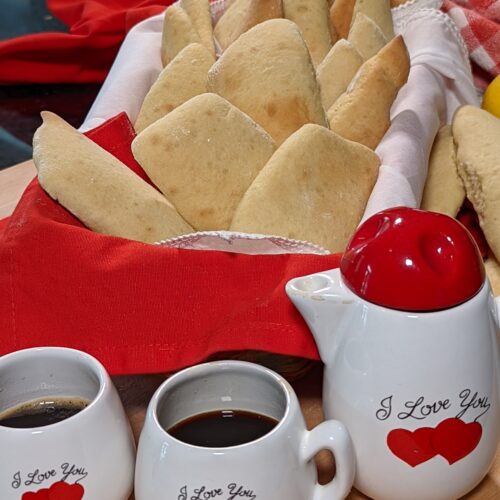
Pastette (Calabrian Milk Cookies)
This recipe is so nostalgic for me because it brings me right back to my childhood. My mom baked regularly and made this recipe every couple of weeks so that my sister and I could enjoy "pastette" for breakfast. Cake-like and lightly scented with lemon, this traditional Calabrian recipe was handed down from generation to generation. The most difficult part of the recipe is shaping the dough in the traditional diamond shape. While it does take a little practice, you can also consider using a spoon to drop the cookies on the baking sheet or forming the dough as loaves. These alternatives are described below.
Ingredients
- 6 eggs room temperature
- 12 ounces granulated sugar
- 1 lemon
- 8 - 10 drops food-grade lemon essential oil (optional)
- 7 ounces vegetable or canola oil do not use olive oil as it is too heavy
- 8 ounces milk
- 15 g ammonia bicarbonate
- 5½ cups all-purpose flour (more flour for surface)
Instructions
- Pre-heat oven 325°F.
- Wash lemon. Zest the whole lemon and juice only half. Set aside. (Reserve the other half lemon for another purpose.)
- Beat the eggs in a large bowl for a couple of minutes.
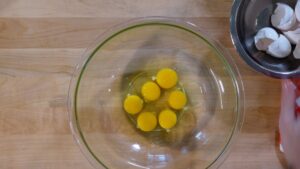
- Slowly add the sugar.
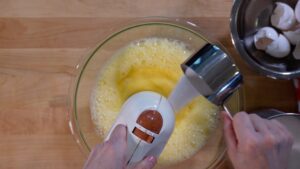
- Continue beating for about 4 to 5 minutes or until the mixture has increased in volume and lightened in colour.
- Stir in the lemon zest and juice. Add essential oil if using.
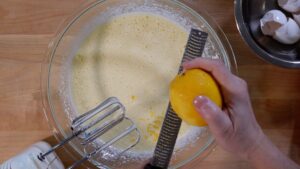
- With the beaters on medium, slowly add the oil in a stream.
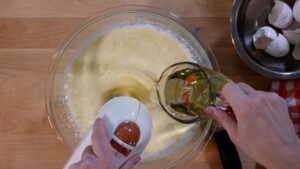
- Bring the milk to barely warm using the microwave or stove. Sprinkle in the ammonia bicarbonate and stir. The mixture will begin to foam slightly. Slowly add the milk mixture to the egg mixture using low speed. Don’t worry about the smell of ammonia. It will dissipate while baking.
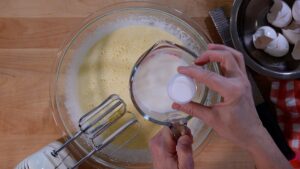
- Gradually add the flour, about ½ cup at a time, beating to incorporate. When the beaters become strained, switch to a wooden spoon to gradually blend in the rest of the flour. If you are using a stand mixer, you may not need to switch to manually mixing. The batter will be sticky and thick but still pourable.

Traditional Method of Preparing Pastette
- Line 2 - 3 large baking sheets with parchment paper, depending on if you like the pastette to touch as they spread during baking or not.
- Sprinkle about 1 cup of flour on your work surface to a diameter of about 30 cm.
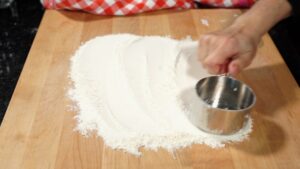
- Scoop about ⅓ of the batter on the centre. It will spread slightly.
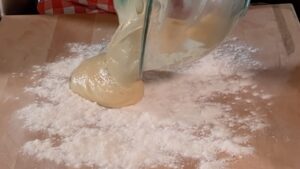
- Sprinkle a little flour on top and pat down lightly to a thickness should be about 1 to 2 cm. Run the tines of a fork on the surface to release air bubbles.
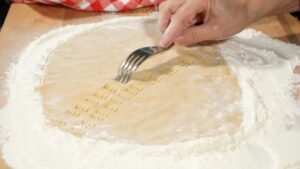
- Using a bench scrapper, cut a 5cm (2 inch) strip, trying to separate it from the rest of the mass. Dip the scrapper into flour after each cut to prevent sticking. Then cut the traditional diamond shape from the strip, about 5cm wide, dipping the scrapper into the flour after each cut.
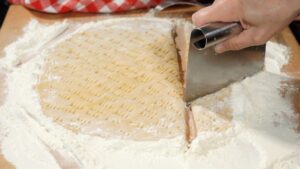
- Switch to a slotted flat spatula and a quick motion, lift the pastetta off the surface. Be careful as the dough is quite soft. Gently shake the spatula to encourage the flour from the bottom of each pastetta to be released. Then, gently place on the baking sheet. Each pastetta may vary slightly in size and shape.
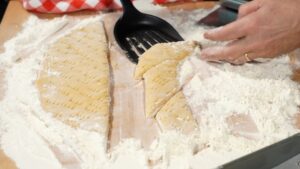
- Typically, the pastette are placed within 2 cm of each other so that during the baking time, they will spread and touch. If you prefer to not have them touch, then place them about 4cm apart on all sides. Bake for about 20 to 25 minutes or until they are lightly coloured on the edges. Typically, these pastette are very pale in colour but you can bake them a little longer if you prefer a little more colour.
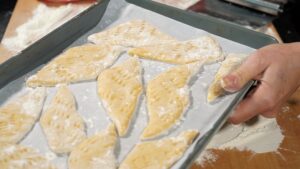
- Once done, remove baking sheets from oven. Let stand a few minutes before lifting each pastetta from the pan. Gently separate them if they have joined. You can use a sharp knife to cut them apart but traditionally, you just gently tear them apart. Place the pastette a cooling rack.
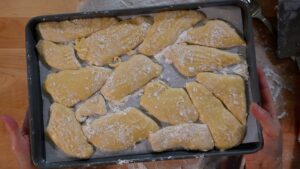
- When cool, use a clean dry dishcloth to brush off the flour from the top and bottom. Store in an airtight container or freeze.
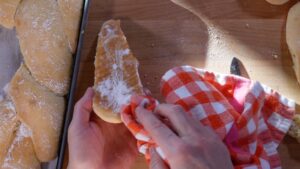
- Loaf Method:
- Prepare 2 or 3 baking sheets (about 9”X12”). For each pan, fold a large piece of foil paper lengthwise and place it opened on the baking sheet, ensuring that the fold is centred lengthwise and facing up. The fold creates a divider between two loaves. Lightly grease the foil and fit a parchment strip lengthwise on each half. Repeat for the second baking sheet. Take note that this dough will make 3 loaves. (One side of the second baking sheet will be empty). There is no need to grease or flour the parchment paper.
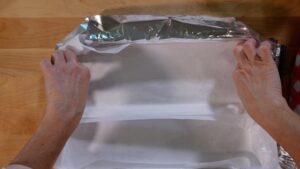
- Pour ⅓ of the batter in each side. Use an offset spatula to spread the batter evenly, especially in the corners. It may be helpful to dip the spatula in warm water so that the batter does not stick to it. Shake the pan slightly or bang it gently to remove any air bubbles.
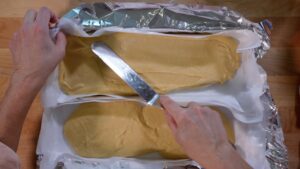
- Bake in the centre of the oven for about 30 minutes or until they are lightly coloured on the edges. Typically, these pastette are very pale in colour but you can bake them a little longer if you prefer more colour. Remove from oven and let stand for a couple of minutes. Then remove each loaf from the pan and remove parchment paper.

- Place on a cooling rack. When cool, slice each loaf. Store in an airtight container or freeze.
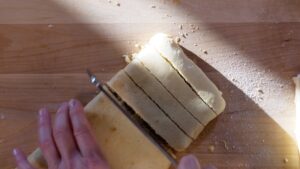
Notes
- Although you can use eggs right from the fridge, room temperature eggs will yield more volume when you beat them. Place the eggs in a bowl of hot tap water while you prepare the baking pans and assemble the rest of the ingredients. Then they will be ready to crack.
- The loaf method is much easier and takes less time to prepare.
- Adding more flour may make it easier to shape the diamonds but it will result in a denser dough. The flavour will be the same but the pastette will not be as cake-like. It takes a little practice to lift the pastette intact. If this method is proving to be too tricky, consider using a spoon to drop the dough in mounds on the baking sheet. Flatten lightly.